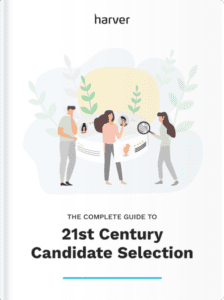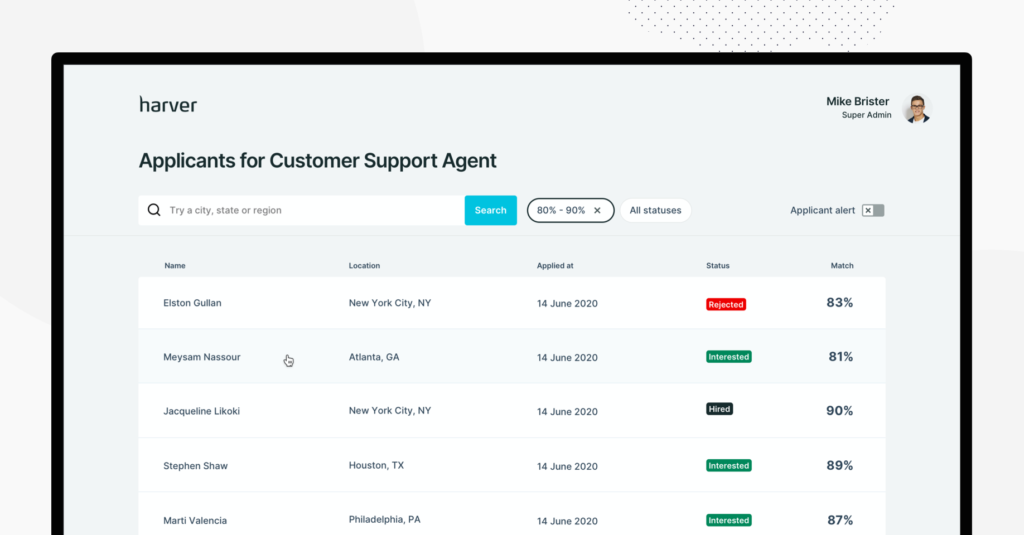Companies use various recruitment metrics to measure the efficiency of their recruitment efforts. Two of these metrics are employee attrition and employee turnover.
The terms employee attrition and employee turnover are often used interchangeably, but they represent different types of employee churn. So let’s see what the differences are and how can you control them.
What's in?
Employee attrition vs. employee turnover
Both employee attrition and employee turnover refer to the speed with which a company gets through its staff. Both cost you in terms of time and money, however, employee attrition is usually beyond your control, whereas you can actively work to limit employee turnover.
What is employee attrition?
Employee attrition refers to the lifecycle of your workforce: it is not normally a negative representation of the company.
Employees move away, pass away or retire; they could leave to raise a family or go back to school. Regardless, whatever their reason for leaving your company isn’t because they have an issue with you, it is merely a result of life happening.
However, when unwanted employee attrition takes place, this is normally a result of the company downsizing, struggling financially, or going in a new direction. In both cases, the position is unlikely to be filled again.
What is employee turnover?
Employee turnover, on the other hand, could be a result of poor hiring decisions or even a hostile or discriminatory work environment.
Employee turnover usually applies to those members of staff who left the company due to termination, taking a job they deem better, or because they believed they couldn’t grow or further their career with your company.
When employee churn occurs due to turnover, usually the vacated position needs to be filled quickly.

75%
of the reasons employees leave could have been prevented by the employer.
Source: Work Institute
Difference in cost between employee attrition and employee turnover
Just as the definition of employee attrition and turnover differ, so too does the cost of each of them.
Seeing as employee attrition is synonymous with a company looking to reduce costs via shrinking labor, either through not replacing leaving employees or through layoffs, the outlay of this activity should be minimal – it is a cost-cutting method after all.
However, if a member of staff chooses to leave of their own accord prematurely, this results in a vacancy that needs to be filled. Turnover can cost twice as much as a normal hire, especially if the employee had not been in post long.
The average cost to hire is $4,000, which is on a par with the average cost to hire after employee turnover, which stands at $4,129. So if you’re hiring twice in one year for the same job, that is going to add up quickly.
In short, while employee attrition might serve as a way of cutting costs, employee turnover increases the spending.
There is an overlap in cost between attrition and turnover, because turnover, while sometimes viewed negatively, can help the company’s bottom line, particularly if the company is going through hard times.
One bonus if a member of staff leaves the company for pastures new is that, if said employee isn’t an essential member of staff, the company won’t urgently need to fill their vacated spot and could implement a hiring freeze for the role until it’s needed again, thus saving money.
Like what you see?
Don’t miss out. Subscribe to our quarterly digest to get the latest TA and TM resources delivered right to your inbox.
A deep dive into employee turnover
Employee turnover rate
The rate with which employees turnover is more indicative of the company than the employee. A high turnover rate could be a result of poor working conditions i.e. low pay or a lack of training, or bad hiring decisions.
Whereas a low employee turnover rate demonstrates a company culture and work environment where employees feel valued, are satisfied in their work, and feel they can progress in their career paths.
So how do you know if your company has a normal or above average rate of employee attrition or employee turnover?
According to the Bureau of Labor Statistics, in 2017 the average employee turnover rate was 15.1% of the total US workforce. These people either quit their job voluntarily, retired, or were laid off or discharged from their post.
Other studies have lowered the average rate to 10%. So a good benchmark for your company would fit between the two.
Four industries with the highest rates of employee turnover:
The food service industry.
This industry has the highest turnover rate due to low wages, seasonal work and a younger than average workforce. In 2016, according to the National Restaurant Association, the average employee turnover rate was 72.9%.Hospitality industry.
Non-management hospitality worker turnover rate is high due to low wages and the requirement to deal with large volumes of customers. The turnover norm for the hospitality industry is between 31-34%.Warehousing.
Staff who work in warehouses are expensive to replace, with the average cost to hire being 25% of salary.Transportation.
According to data by Uber, 11% of new employees are gone within a month, 50% within a year.
Stop guessing,
Start data-driven hiring.
Learn how you implement a modern candidate selection process, that is: streamlined, experience-driven and backed by data.

Consequences of employee turnover
Apart from costing a lot of money, employee turnover has other consequences for your business.
Although it might have some benefits:
- Getting rid of poor performing employees.
- Opening up for an opportunity to hire people who fit the job and company better.
There are more negatives:
- Could be a result of a more serious issue within the workforce.
- Prevents you from focusing on your job: to grow the company.
- Replacing employees is a time-consuming and costly process. If you’ve just filled the role, you could be shelling out again for it.
- Whilst HR is working tirelessly to fill that role, they aren’t focussing on filling other, just as important, roles.
Can you predict employee turnover? Well, there are a few obvious precursors you can keep an eye out for:
- Absenteeism. This could be through work-related stress, or it could because the employee is applying for jobs and interviewing elsewhere. Question why they aren’t in the office.
- Disengagement. 37% of engaged staff are looking for opportunities elsewhere compared to 73% of actively disengaged staff. Expect the resignation of staff who’s zoned out.
- Low productivity. Unhappy staff produces 10% less work than happy staff. If you’ve noticed a decline in output, they could be working up to leaving.
How to prevent excessive employee turnover
If you want to prevent a high employee turnover rate, you have to start by looking at your hiring process.
- Hire people who you’re sure will fit the job and the organization.
- Use pre-employment assessment software during the hiring process to assess candidates and predict their success in the role.
- Ask current staff members for referrals. Start an employee referral scheme.

Continue with onboarding and regular check-ins with your staff.
- Onboard each new hire efficiently and ensure they understand the company and what is expected of them.
- Conduct regular performance reviews to ensure staff are on track. Carry out unofficial check-ins to show you care.
- Ensure all issues are resolved quickly to prevent the problem from escalating.
- Adopt an open door policy so staff know they can have your ear if they require it.
Keep the focus on employee development, learning, and growth. Develop an attractive compensation package.
- Challenge staff and help them be fulfilled in their work.
- Allow staff to grow and provide room for them to stretch their wings.
- Pay your employees competitively. If you aren’t sure, check with the U.S. Department of Labor Occupational Outlook Handbook. If you can’t match a competitor’s salary, look to offer incentives elsewhere: flexitime, flexible workings, extra vacation days, office perks, a new laptop.
Despite your best efforts, there is always going to be employee turnover, sometimes, you just can’t please everyone. However, don’t be complacent. Consider conducting exit interviews to learn why the employee is leaving. You might start to see patterns if you’ve conducted a few recently.
We’ve detailed the topics of employee turnover in the retail and hospitality industries in the articles below.
A deep dive into employee attrition
Generally, employee attrition is considered a natural process. This is true to some extent but there are instances where attrition can be prevented as well.
There are some forms of employee attrition that employers cannot control, for example:
- Retirement
- Resignation
- Personal health
Then there are the forms of employee attrition that employers can control, such as layoffs or elimination of positions.
Consequences of employee attrition
While employee attrition can at first appear to be detrimental to a business, it isn’t always so bad. Employee attrition can have its advantages:
- For a company or organization that is facing financial distress, employee attrition can help to relieve a little pressure on the purse strings by cutting wage costs.
- Having to get rid of employees usually involves a more amicable departure from the organization, because attrition is a fact of work life.
However, it might cause trouble in your workforce:
- By reducing the size or strength of the workforce, you are reducing the potential growth of the business. Employees who were anticipating a fast growing business will quickly become disgruntled if the business’ direction suddenly changes.
- Reducing staff can result in the remaining job duties increasing the workload of remaining employees, as they have to pick up the slack. Expecting staff to maintain the pace and scale of work that they were running at with a full team, is unrealistic. Anticipate grumbles from overworked staff and a significant reduction in output too.
- Eliminating a role might lead to impossibility of a promotion and stymie or jeopardize the career trajectories of certain members of staff who were relying on filling that role at some point in the future.
- You could lose valuable employee knowledge.
- It can create a domino effect when one employee leaves and is deemed successful in their new venture.
Preventing and managing unwanted employee attrition
Sometimes, it might be better to prevent unwanted employee attrition, e.g. layoffs, and that can be easier than you think:
- Carefully consider your hiring needs in the first place and create a hiring plan.
- Create a contingency plan should the worst happen, rather than react with a knee jerk reaction and layoff staff.
- Negotiate a pay reduction with staff for a set period of time rather than lay them off altogether.
- Offer unpaid vacation time to those with families.
- Communicate with staff for their input – they might see where you are spending frivolously, that you might have missed.
However, sometimes a layoff is an inevitable step. So if you have to lay people off after all, how do you manage the situation?
- The first answer is through clear, honest and open communications. If you don’t tell your employees the truth, they’ll make it up.
- Secondly, ensure the top brass do the layoffs, don’t hire in someone from outside and shirk responsibilities.
- Thirdly, provide support and assistance to those being laid off. For example, after a Dutch travel startup Travelbird declared bankruptcy in late 2018, the HR and management compiled a list of employees with a short description their expertise and their contact details (with employees’ consent, of course) and shared it across their professional networks.
Final word
A company is only ever going to be as good as its employees. Innovation is key to growth, and innovation relies entirely on great people. So if you want to be the best, you have to hire the best.
Employee attrition and turnover, whilst a sad fact of business, are costly in more ways than money: they are detrimental to productivity, morale, and revenue generation. So, you have a choice, you can work to minimize employee attrition and employee turnover by investing in employee retention strategies and hiring right from the get-go.
Stop guessing,
Start data-driven hiring.
Learn how you implement a modern candidate selection process, that is: streamlined, experience-driven and backed by data.



